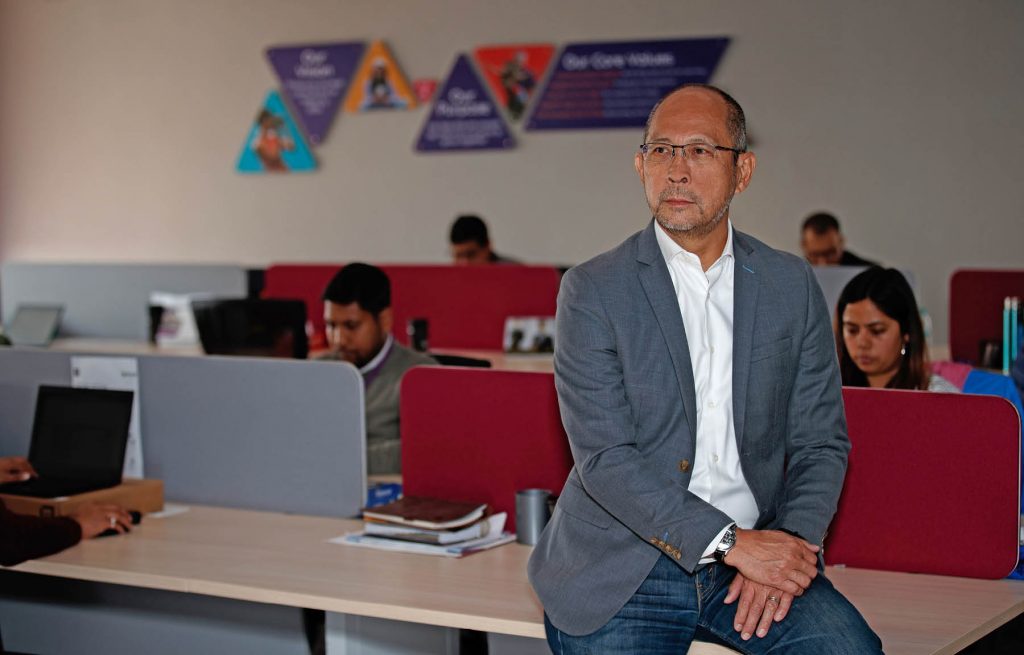Language
You can read the magazine in one of the following languages
Geolocation
You can read the global content or the content from your region

With a mountain coverage of over 75 percent, Nepal’s terrain poses a serious challenge to network operators. However, the potential, according to Ncell Axiata CEO Andy Chong, makes it worth the additional labor and expenses.
“It still is a duopoly market here. We are thinking more about not just growing telecom services, but also the potential for offering advanced services that connect Nepali people with opportunities that these technologies bring,” he tells The CEO Magazine.
With 11,000 cells and over 4,000 mobile towers spread across the country, Ncell provides quality service to customers spanning from the high-land Everest region to the low-land plains of the Terai region.
“For 4G, we provide coverage to around 88 percent of the population. From a telecom service coverage perspective, which includes 2G, 3G and 4G networks, it’s over 92 percent,” Chong says.
But despite its profitability, Chong acknowledges there’s no lack of obstacles specific to Nepal when it comes to delivering quality service.
“The last five percent of the population here presents a real challenge for any operator to address because of the terrain beyond the central midline of Nepal and moving up north,” he explains.
“It becomes prohibitive, not just economically, but also physically.”

“From a telecom service coverage perspective, which includes 2G, 3G and 4G networks, (coverage) is over 92 percent.”
Heights and rugged regions are not the only issues here. “To build a site in what we call ‘the mid hills’ at 2,000–3,000 meter levels and beyond, we use people wearing headgear and other traditional modes for carrying loads, including all steel structure materials, up that terrain,” he says.
He says this not only costs four-to-five times more but also takes a significantly longer time. Building new towers in these regions also involves getting clearance from the Ministry of Forests and Environment and the community’s support, as the majority of these areas are protected terrains.
Chong is of the view that every investment that a company makes should generate a return on investment. “But for many of our sites, like the ones we have in the Everest region and in some of the trekking sites, they’re unlikely to generate a return in comparison to what we’ve invested in, as we don’t get enough usage in these sites,” he explains.
The lockdowns created by the COVID-19 pandemic have been an accelerator for Ncell where digitalization is concerned.
“Immediately post-lockdown, sometime in the second quarter of 2020, we learned the importance of a digital customer journey the hard way, in that we were not able to serve our customers, with all point-of-sales closed for extended periods,” Chong reflects.
“We saw the need to immediately embark on significantly investing in a digitalization program to drive customer engagement and the value chain that has direct impact on customer experience and engagement.”
Ncell launched several digital initiatives to serve its subscribers and engagement was expanded on several fronts, from introducing chatbots and electronic recharges to channel apps including eKYC (Know Your Customer).
He says there’s significant opportunity for Nepal to grow by embracing digitalization, as envisioned in the government’s Digital Nepal Framework. “We were the first operator to implement eKYC for customer acquisitions,” he says proudly.
Chong says that from a supply and demand perspective, Nepal is not ‘digital’ enough. “Had Nepal been up the curve in terms of its digital economy, the impact of the COVID-19 pandemic would have been lessened with easy access to services for customers,” he says.
“Our aspiration is to be a digital telco in line with Axiata Group’s vision to be the Next Generation Digital Champion.”
For a telecom company with a turnover of over US$500 million, Ncell has a surprisingly small staff strength of 532 full-time employees.
“We believe we’re definitely efficient in serving our customers and getting business done, and we have a relatively young and dynamic set of colleagues who are innovative and committed to the business,” he says.
“From my perspective, all the focus on success of digitalization is not about technology, it’s about people, organization and conviction.”

“From my perspective, all the focus on success of digitalization is not about technology, it’s about people, organization and conviction.”
He’s a strong advocate for a capable and can-do organizational attitude. “All the work we do is less about understanding technology and more about organization and people. It’s about making sure the organization is enabled, that the teams are motivate and the right attitudes are in place,” he says.
“We pride ourselves on the contribution and work we do for the people of this country. In this day and age, consumers, partners and vendors will only want to work with companies that they believe are committed to protecting the environment, delivering a sustainable engine for growth and governance.
“I like to think Ncell has one of the highest standards of ESG frameworks and philosophy in Nepal, and one that we practice within the business everyday in all we do.”
On top of this, Ncell also has strong CSR initiatives. It’s one of the largest taxpayers in Nepal; since its inception the company has contributed over US$2.14 billion in taxes and fees as of the 2021/22 fiscal year, supporting government in public financing.
Chong reveals that, where Nepal is concerned, there’s a constant question of where the company should invest in its networks beyond its ‘business-as-usual’ requirements.
Should new mobile towers be built in the densely populated areas of the southern corridors of Nepal, or in places such as the base camp of Mount Everest and Annapurna ranges, where the population is low and the cost of construction and maintenance high, despite its high tourist and marketing value?

“Customer intimacy ... drives everything we do and permeates in every aspect of our business decisions and actions.”
The Government of Nepal has a strong aspiration to drive Digital Nepal, and Ncell is set to support that goal. “Hopefully, sometime soon, we should be able to roll out IoT devices with a vehicle distributor with embedded eSIMs. Despite the fact that such innovation is still in its infancy in this market, it’s a positive potential development. It’s an indication of why we believe this market has other growth potentials,” Chong says.
He also believes Ncell has reached a stage where the company can afford to choose customer engagement over price leadership, delivering customer intimacy through operational excellence.
Chong envisages a perfect customer interaction system that doesn’t require call or service centers.
“I often wonder why successful companies like Amazon and Uber don’t have call centers. Why couldn’t Ncell also deliver customer service purely via digital channels, be it online, social media, email, chatbots or crowdsource?” he asks.
“If you have a problem, you should be able to email, text or simply use an online resource. We hope to realize this vision of customer intimacy from an operational excellence perspective in the near future.”